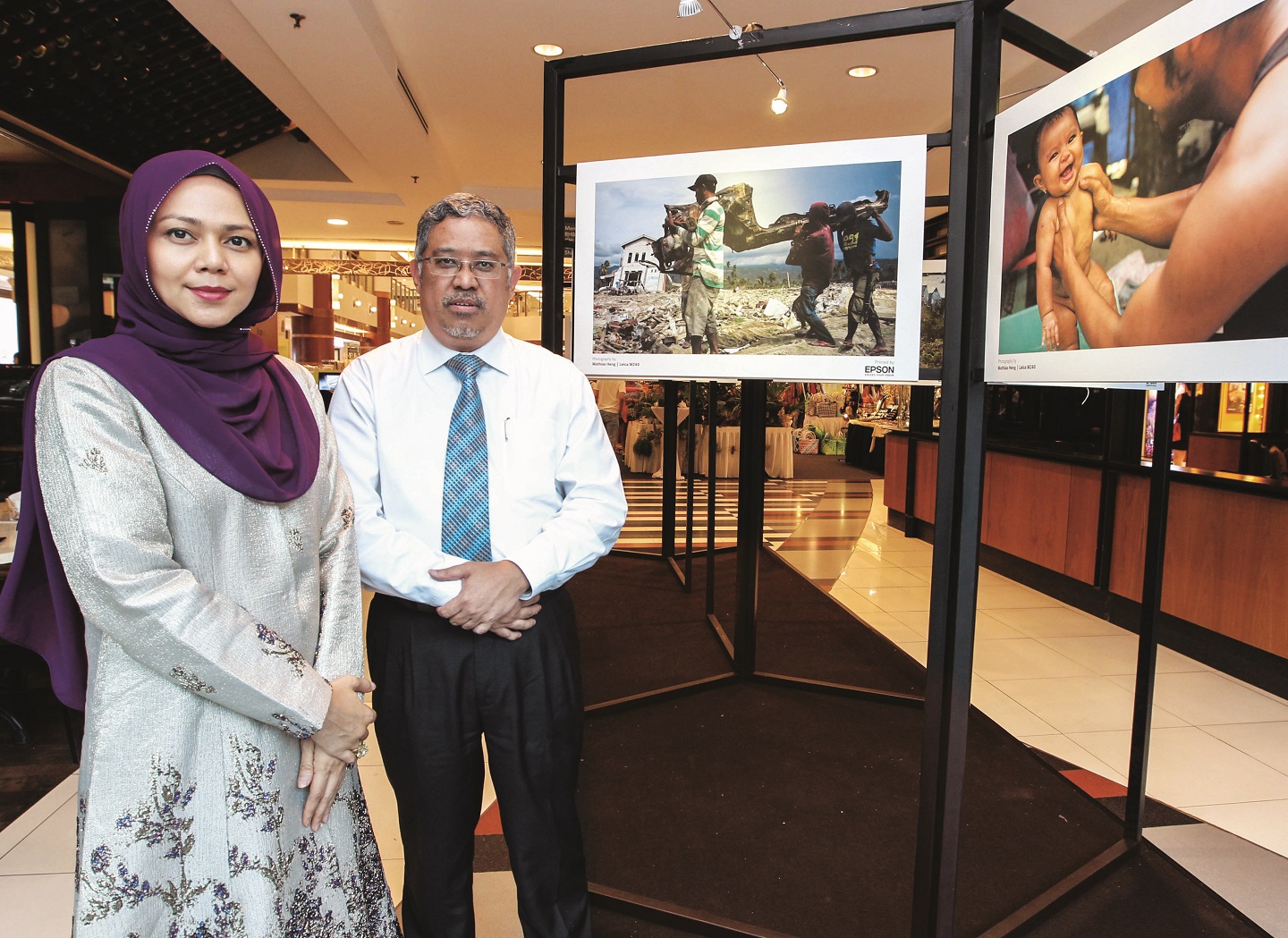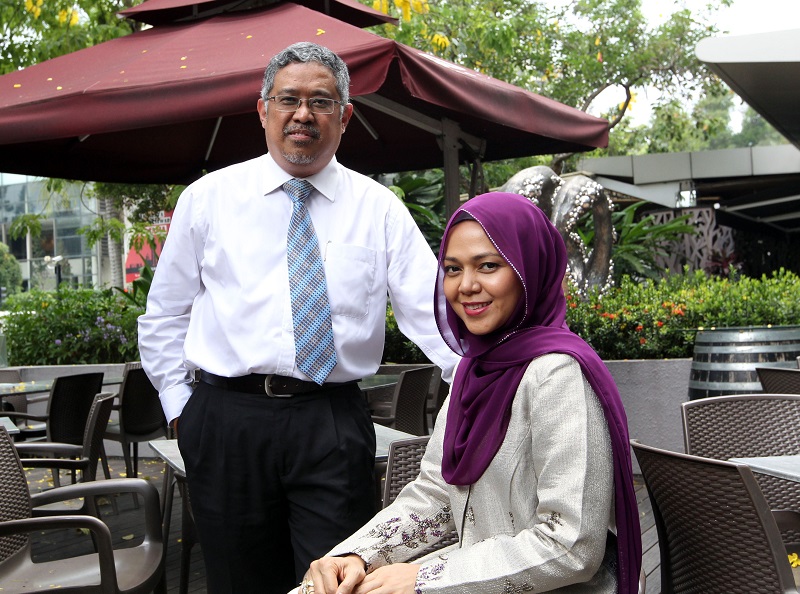
Wulan (left) and Mohd Daud before some of the photos taken by Heng, depicting his personal experience in Palu (Photo: Kenny Yap/ The Edge)
In 2018, a series of natural disasters rudely disrupted the lives of hundreds of thousands in two parts of Indonesia. Several earthquakes and powerful aftershocks that hit the island of Lombok killed over 500 people and left more than 400,000 homeless. Not long after, an earthquake, tsunami and soil liquefaction in neighbouring Palu resulted in 2,000 casualties and rendered 59,000 homeless.
According to Dr Mohd Daud Sulaiman, president of the Malaysian Relief Agency (MRA), it is estimated that 15,000 people remain unaccounted for. At the time of the interview, he had just received a call informing him that a body had been washed up on the beach, and he foresees it will not be the last.
Without getting into the emotional and psychological trauma, the damage to infrastructure alone is estimated to have affected more than 67,000 homes and 600 schools. In order to rebuild houses in the affected areas, MRA recently organised a fundraiser called Affect Nusantara. At the forefront of this fundraising effort is businesswoman Wulan Amaraja Moiz, who initiated it upon learning that victims of the disaster were still living in tents months after the disasters — a situation that posed sanitation and security risks.

“I felt like I needed to do something for my home country ... I cannot live comfortably at home while knowing that there are people still suffering,” says Wulan, who hails from Indonesia but lives and works in Malaysia.
A visit to Palu in December last year, a few months following the disasters, left a great impact on her. “I thought to myself, ‘It has been three months after the disaster, it can’t be that bad’. But I was shocked to see how everything was still in bad condition. We had a meeting with the deputy mayor in Palu and found out that the government was struggling to cope,” she explains.
For MRA, which focuses on aid and relief following natural disasters or armed conflicts, an initiative like this is certainly not a first. The organisation, which has a long-term satellite office in Palu, sent 25 doctors, nurses and paramedics to both areas in the first three months of the disaster. “MRA emphasises on Malaysia and neighbouring Asean countries. So, the term Nusantara fits us well. But at the same time, we do not forget about other countries such as Nepal and Yemen,” says Mohd Daud. MRA’s emergency relief projects have taken the humanitarian organisation to disaster-stricken areas in Bangladesh, Bosnia, Egypt, Indonesia, Japan, Myanmar (the Rohingya crisis), Nepal, Pakistan, Palestine, the Philippines, Somalia, Sri Lanka, Syria, Thailand and Yemen.

MRA has been around for about 10 years but Mohd Daud’s personal journey as a volunteer spans two decades beginning from his days of practising in Hospital Kuala Lumpur. The young doctor ran a clinic in the squatter areas of Kampung Segambut, Kerinchi, Setapak, Sentul and the orang asli community in Hulu Langat. Every Sunday from 4pm to 7pm, he visited these communities in a donated van driven by a hospital employee who was also keen on volunteering. On days when the volunteer was unavailable, he would drive the van himself. His wife, also a doctor, would follow him on these rounds to help with dispensing medication. He recalls how his then four-year-old son, now a medical doctor too, followed them to play with the children while they attended to patients. “I work on my volunteer initiatives every day, even if it means having the occasional meeting until 2am. But it is always after work,” says the consultant cardiologist at KPJ Damansara Specialist Hospital on enforcing a clear separation between his day job and volunteering.
MRA is also concerned with economic empowerment and is currently looking into house-bound jobs for the womenfolk and reviving carpentry and fishing as an income source for the men. Mohd Daud estimates that it will take about five years to rebuild a community after a disaster of this magnitude. A similar approach was taken in Padang, where 50 sewing machines were donated to the community, which enabled them to continue border stitching as their main source of income.
While Mohd Daud and Wulan opine that reviving livelihoods is of great importance, the primary focus at the moment is housing. Rumah Syukur — a name that refers to the sustainable shelters built by MRA — was first used in 2009 in its Padang project, which saw 400 houses built within the six months following an earthquake that killed hundreds.
Each Rumah Syukur has a lifespan of 10 years. The houses come with a basic living room, kitchen and two-bedroom structure. “What’s unique about these shelters is that they can be expanded from the basic model into a larger family-home according to their needs. Rumah Syukur will be built on the site of the disaster victim’s original homes, as for many of them, it is the only life that they know and understand,” Mohd Daud explains. He adds that while this task needs to be undertaken fast, it needs to be done properly. Part of the prerequisite groundwork includes establishing the rightful owner of a particular parcel of land or house that once stood on it. In the meantime, the construction of medium-sized wells that can cater to the needs of three to four thousand people each began last month and is ongoing.
The name, Affect Nusantara — signifies the underlining historic and cultural bonds between Malaysia and Indonesia, both within the Nusantara region. The funds to build these houses comes from three key events that have already taken place. The first, a contemporary art exhibition at Artcube curated by Zena Khan, which feature works by Ahmad Fuad Osman, Amir Amin, Anniketyni Madian, Azad Daniel Haris, Eng Hwee Chu, Fadli Yusoff, Fauzan Omar, Haafiz Shahimi, Husin Hourmain Izzat Hamdan, Kamal Sazali and Zulkifli Yusoff. The second, is a photo exhibition by photojournalist Mathias Heng, and third, a showcase by designers from the two countries that was held at Bangsar Shopping Centre.
The amount raised through these initiatives will fund about 100 Rumah Syukur — the actual number will depend on the final amount raised. Planning and construction is slated to start in the second quarter of this year, with a substantial number of the houses to be located in Palu. Once they are officially handed over, survivors of the disaster will finally be able to leave the sweltering tent cities they have been living in for months now, and move into more permanent housing where they can safely focus on rebuilding their livelihoods and, ultimately, their lives.
The article first appeared on Apr 22, 2019 in The Edge Malaysia.


